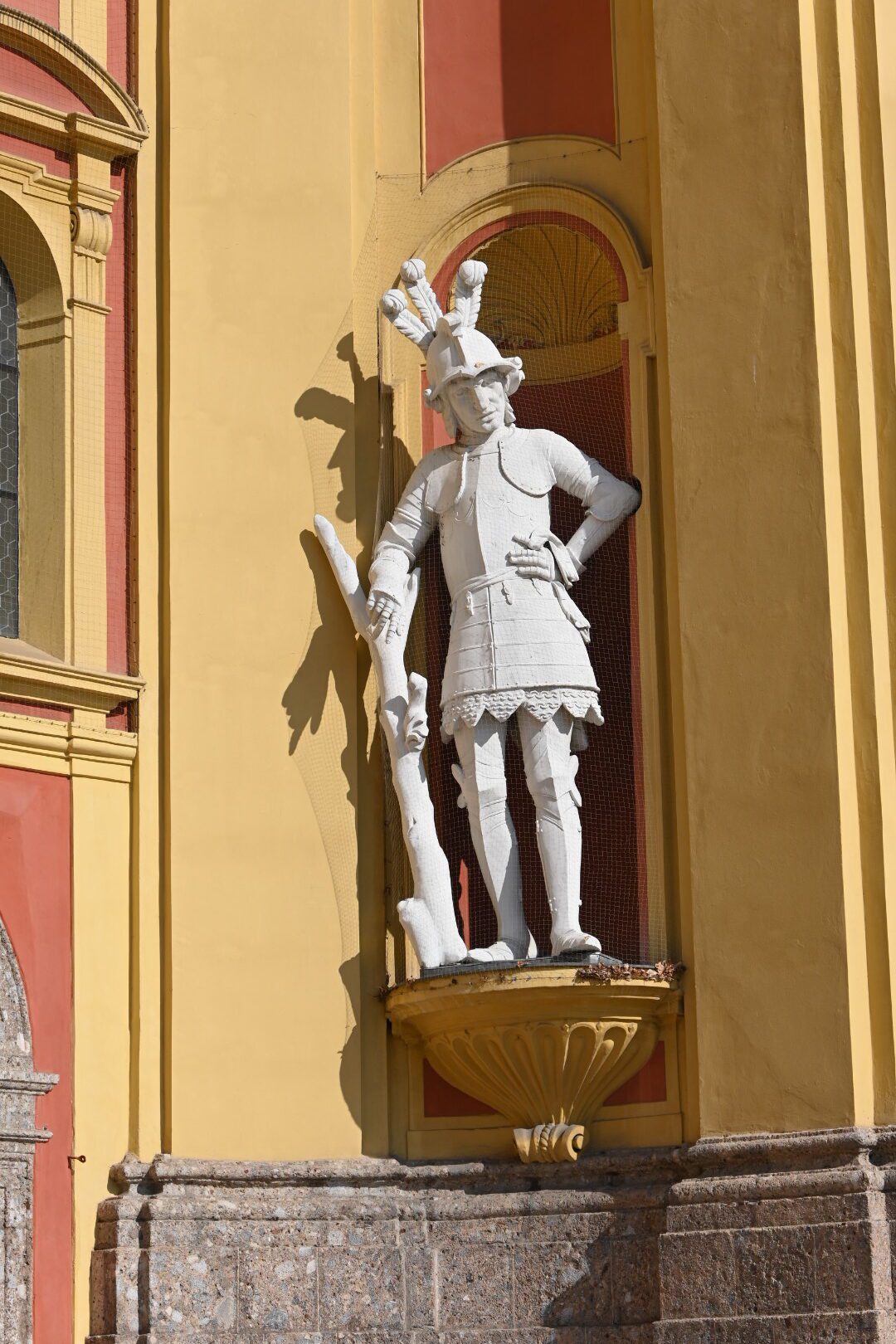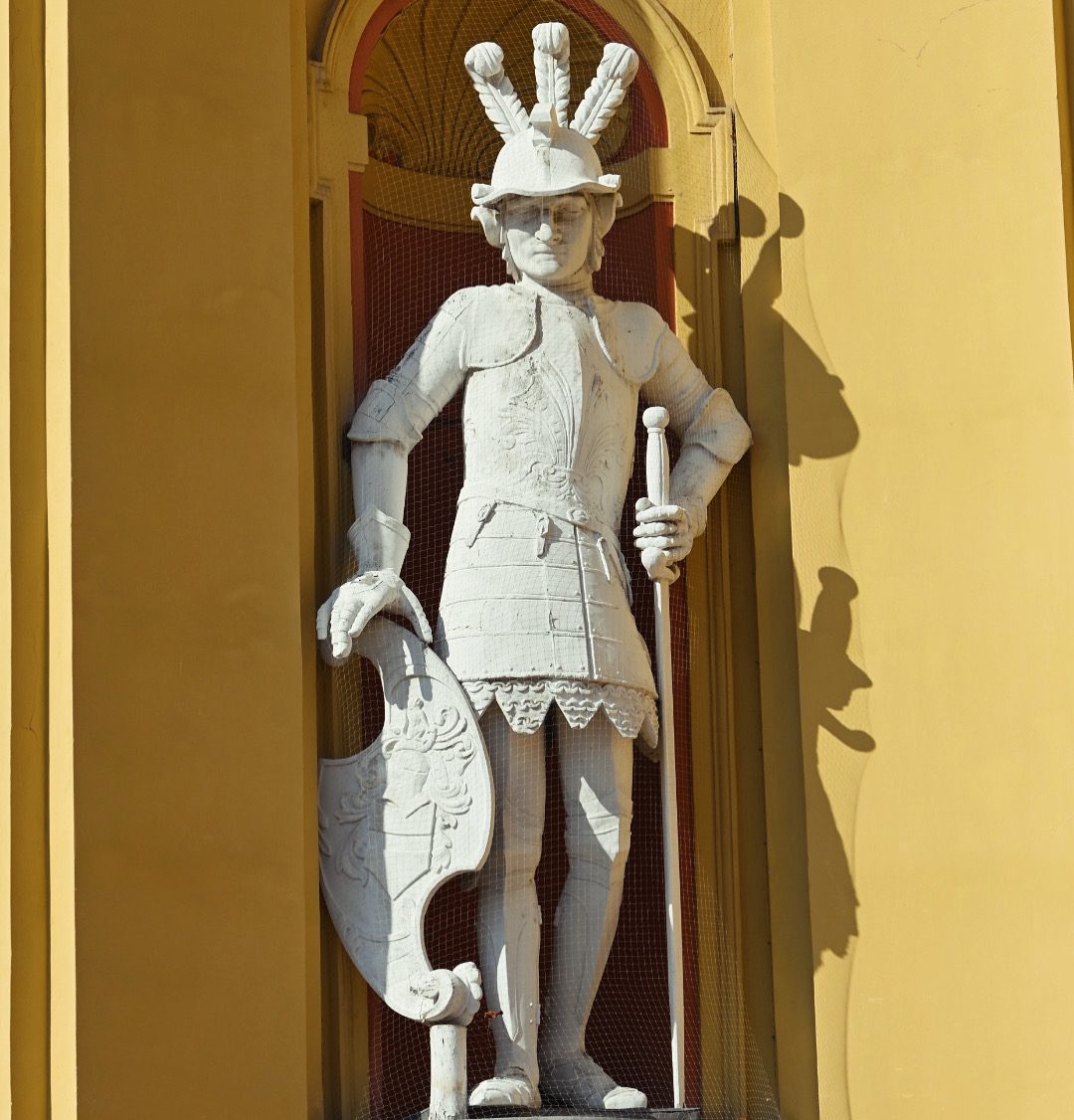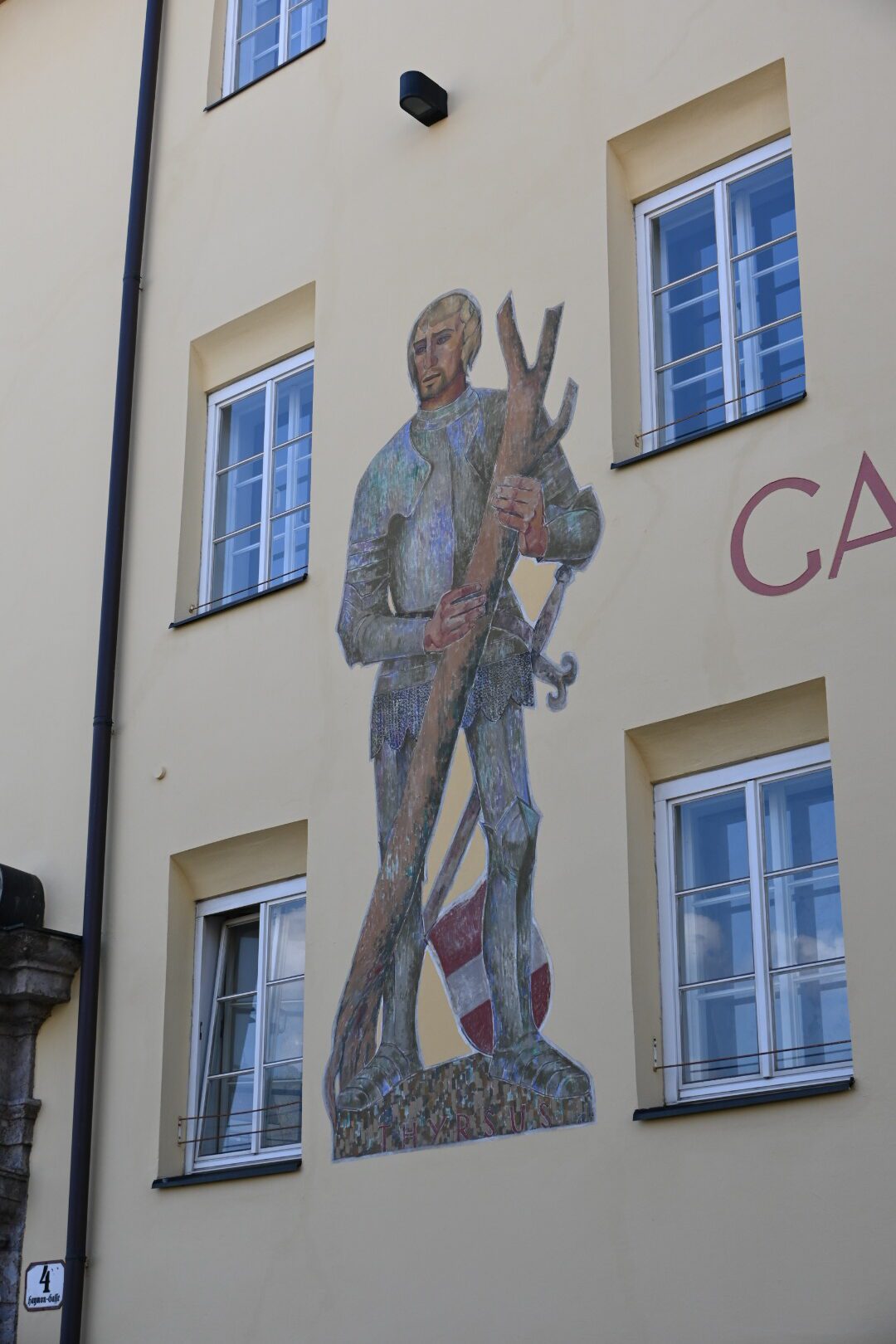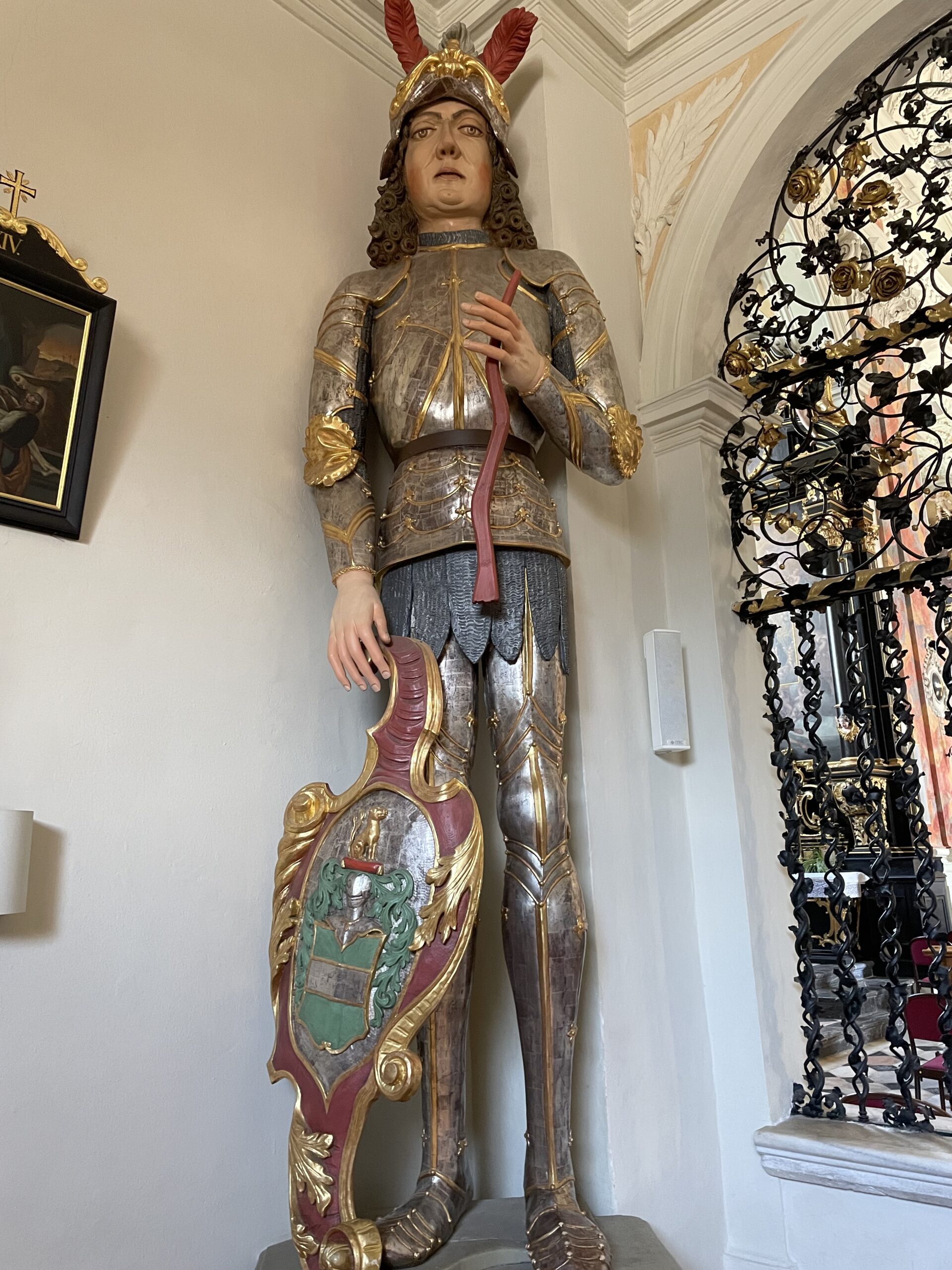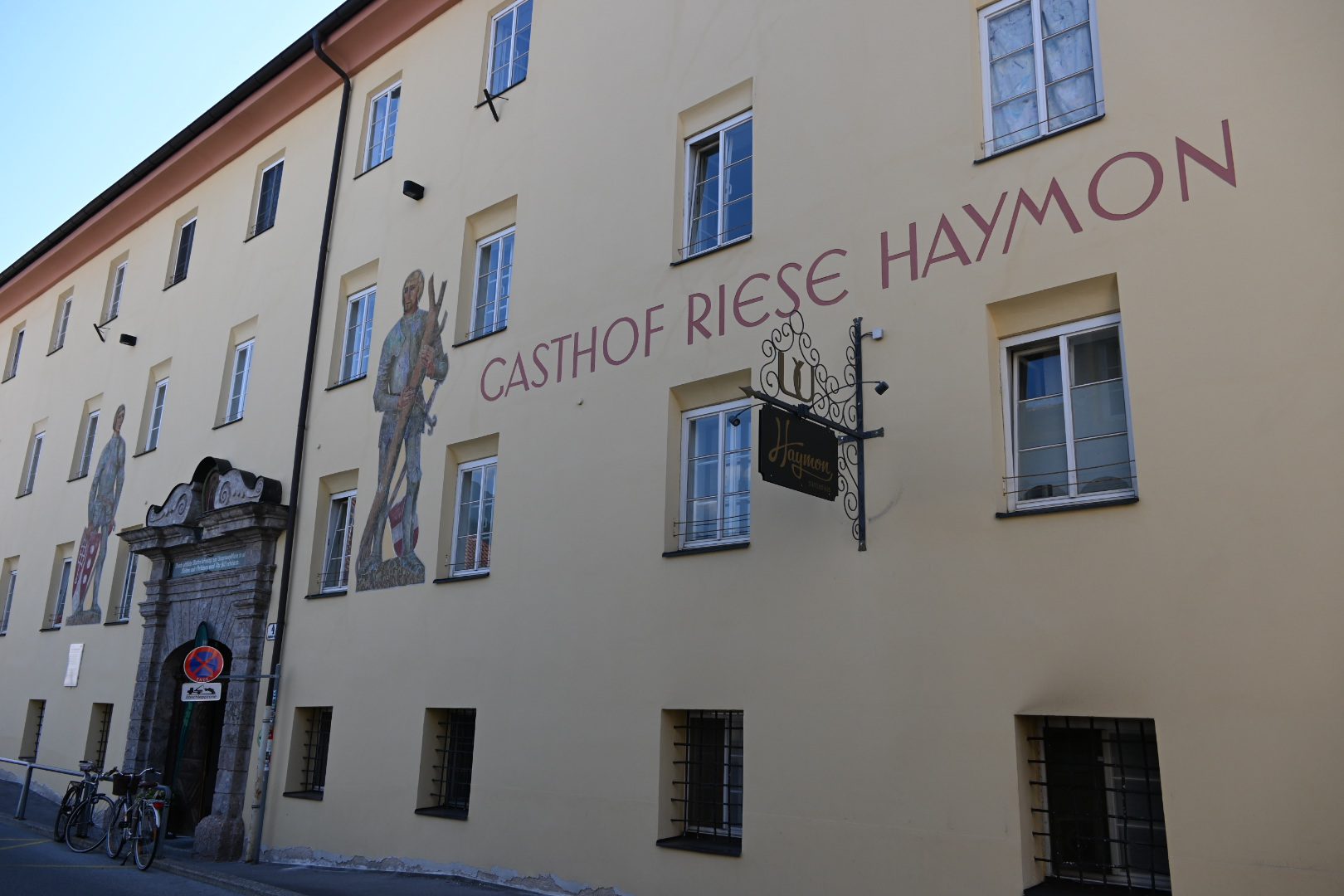Thyrsus, Haymon and the Bavarians
Thyrsus, Haymon and the Bavarians
After the disappearance of the Western Roman Empire and its associated administration, Germanic tribes took control of the area that is now Innsbruck. Between the turn of time and the coronation of Charlemagne in the year 800, the period known as the Migration Period, Late Antiquity or the Early Middle Ages, a whole range of peoples were to be found in what is now North Tyrol. Breons, Romans, Goths, Lombards, Bavarians, Suevians and Slavs settled next to and behind each other in various areas north of the Brenner Pass. The Bavarians were able to assert themselves as a regional power in the central Inn Valley. During the land conquest, the Castell Veldidena The transition to Bavarian rule was less sudden and warlike for the Breton-Romanised population, however, and much more fluid. They were not barbarian destroyers, but groups that had been in contact with the Roman world in one form or another for centuries. Fighting was probably the exception. Cultures gradually intermingled at a time when the structure of power was rather loose. The everyday language of the people was a form of Germanic, but Latin had also established itself early on as a written language among the "barbarians" north of the Alps.
However, the most important remnant of the Romans was Christianity. The Bavarians were Christianised from the 8th century at the latest. At the time of Charlemagne (approx. 748 - 814), the Dukes of Bavaria and with them the Inn Valley became part of the Heiligen Römischen Reicheswhich extended over large parts of central Europe and northern Italy. The rulers relied on the ecclesiastical structures of the Romans to administer the territory, as clerics were often the only scribes. Instead of Roman emperors, an arrogant aristocracy ruled in the name of God over their subjects, who were agricultural labourers, as feudatories of Charles, King of the Franks, anointed by the Pope. The Christian church father Paul wrote in his Letter to the Romans laid the theological foundation for this system:
Jedermann sei untertan der Obrigkeit, die Gewalt über ihn hat. Denn es ist keine Obrigkeit außer von Gott; wo aber Obrigkeit ist, ist sie von Gott angeordnet. Darum: Wer sich der Obrigkeit widersetzt, der widerstrebt Gottes Anordnung; die ihr aber widerstreben, werden ihr Urteil empfangen. Denn die Gewalt haben, muss man nicht fürchten wegen guter, sondern wegen böser Werke. Willst du dich aber nicht fürchten vor der Obrigkeit, so tue Gutes, dann wirst du Lob von ihr erhalten. Denn sie ist Gottes Dienerin, dir zugut. Tust du aber Böses, so fürchte dich; denn sie trägt das Schwert nicht umsonst. Sie ist Gottes Dienerin und vollzieht die Strafe an dem, der Böses tut. Darum ist es notwendig, sich unterzuordnen, nicht allein um der Strafe, sondern auch um des Gewissens willen. Deshalb zahlt ihr ja auch Steuer; denn sie sind Gottes Diener, auf diesen Dienst beständig bedacht.
Culturally, Christianity also proved to be adaptable to traditions and customs in the Alpine region. The martyrs and saints of Christianity replaced the pagan polytheism. Old festivals such as the winter solstice, Thanksgiving and the beginning of spring were integrated into the Christian calendar and replaced by Christmas, All Saints' Day and Easter. Popular legends about miraculous plants, ominous mountain peaks, magical beings such as the Saligen Fräuleinenchanted kings and other legendary figures could easily be worshipped alongside Christianity.
Two of the most popular of these in Innsbruck to this day play the leading role in the founding myth of Wilten Abbey. An extraordinarily strong knight, known as the giant Haymon, travelled to Tyrol sometime between late antiquity and the early Middle Ages. In Tyrol he met the long-established giant Thyrsus von Seefeld. While the Germanic knight Haymon was armed with a sword and shield, Thyrsus, who had a Romanised name but was actually a wild inhabitant of the Alps, only had a tree trunk at his disposal. As it happened, the modern sword struck the wooden club and Haymon killed Thyrsus. In remorse for his deed, he converted to Christianity and was baptised by the Bishop of Chur. Instead of building a castle in the Inn Valley as planned, he built a monastery on the ruins of the Roman fortress of Veldidena. However, a terrifying dragon dwelled in the nearby Sill Gorge, which not only ravaged the new building of the now Christian hero every night, but also made it impossible to settle the area in any meaningful way. Haymon killed the beast, cut off its tongue and bequeathed it to his own foundation. After his career as a dragon slayer, Haymon handed over the monastery to the Benedictine monks of Tegernsee and joined the brotherhood himself as a lay brother. The people of the region were so grateful to the giant for freeing them from the dragon that they gladly placed themselves in the dutiful care of Wilten Abbey in order to cultivate the once wild land as farmers.
In this parable, Haymon stands for the initially violent but later noble and benevolent Germanic colonisers, Thyrsus for the brave and wild but ultimately defeated inhabitants of the region between the Seefeld plateau and the Brenner Pass. The dragon symbolises the evil, destructive and unchristian paganism that is eradicated by the converted Teutons. The monastery brothers, richly endowed by the brave knight, are the organising hand without which nothing would work.
The Haymonsage and their morals were just as flexible over the centuries, depending on the zeitgeist, as Christianity was when it was introduced in late antiquity. One time Haymon was a nobleman from the Rhine who came to Tyrol after the death of Charlemagne, another time he travelled between Ravenna and Germany as a follower of the Ostrogothic king Theoderic, better known as Dietrich of Bern. From the Middle Ages to the 19th century, the conversion HaymonsThe protection of peasant subjects by Christian chivalry and the founding of monasteries took centre stage in order to underpin the beneficial feudal system. In an article in the Innsbrucker Nachrichten of 2 October, on the other hand, the author Dr Franz Wöß left the Catholic element of the monastery building almost completely aside and emphasised the heroic German before turning to the healing properties of thyrsus oil, which the Seefeld farmers had been extracting from the oily slate stones since the Middle Ages. In this version of the legend, Haymon retired to the wilderness in Seefeld as a hermit after his heroic deeds instead of ending his life as a cleric in Wilten Abbey. After the Second World War, however, people wanted to distance themselves as far as possible from Germanism. The 1956 inscription on the façade of the "Inn Zum Riesen Haymon" shows the defeated Thyrsus with an Austrian coat of arms, in keeping with the victim myth of the post-war period.
From the healing power of ash oil
As legend has it, Dietrich von Bern, who travelled along the old Roman road from the south to Tyrol, was also accompanied by the Giant Haymona nobleman from the Rhenish family who was "very pious". He killed another giant, the wild man, in a fight, who devastated the fields and the farmers asked him to continue to protect them as their lord. Haymon's young lordship, however, wanted a local giant from the Seefeld region, Thyrsusnot tolerate.
The battle between the two giants took place where the small village of Zirl lies today on the Oberinntal road. They met at the Reschenfuhrung, as shown in the beautiful painting in the Wilten Abbey Church in Innsbruck. Haymonthe Christian knight with sword and shield, Thyrsusthe heathen brutes, with a monstrous, sharp-toothed Swiss stone pine wood. Haymon was victorious. Thyrsus, struck to death, fled to the mountains outside Seefeld, where, dying, he let his blood flow into the rock so that his peasants could draw healing power from it:
"Go to it, liquid blood,
That's good for animals and people!"
With these last words, Thyrsus honoured the Seefeld and Reither farmers with a valuable asset, the "Thyrsus blood" or Deer oilthe later Ichthyol.
Haymon repented of his misdeed and, as atonement, built the holy and silent work on the site of his battle: Wilten Abbey. He then continued to live as a penitent in a cave on the mountain cone. At the death of his rampart, he once bared the precious oil, as the reconciled place also prophesied.
The farmers of the Seefeld area used this thyrsus remedy as a "local" one by the above deification word. The frequent slate shards with their oil-containing thyrsus liquid vessels were placed on a hearth where they were heated by vapourisation and sweating. Ichthyol The oil, which was obtained from the Seefeld oil fishermen for centuries, was used as a healing oil, for heating ointments such as the Maximilian rooms ointments and rollers used in Brixen or in the Vienna hospital. But ichthyol, stripped of its fine petroleum and resinous residues, unleashes the innermost primal being.
That from Deer oil The idea that it was the blood of the slain giant Thyrsus, as the Seefeld farmers believed when they painstakingly extracted it from the stone high above the Inn Valley, symbolising the struggle between the Germanic tribes with their culture and mountain skills and the indigenous population, is hard to grasp. Ichthyol - according to the Greek text on fish oil - does not give off a toxic or sweet and sour odour, which often occurs with stinky oils.
Just as in the depiction that this valuable healing oil is from a Christian giant, which the giant Thyrsus left him, the idea that organic life was the basis of this lifeblood, the fish and other aquatic creatures, is also prevalent in the naming of ichthyol in the shale putty for human use. However, such fish remains are not usually found in the actual ichthyol shale, but only in the rock; the name ichthyol can therefore not be regarded as so justified because this rock shale and crude oil are undoubtedly particularly rich in sulphur. The Seefeld shale contains up to 10 % crude oil and, despite a lot of resin and fat, little sulphur. The sulphur is said to have completed the healing effect.
The German pharmacopoeia recommends ichthyol against inflammatory processes on the skin and limbs. It also belongs to a noble stock of urotropin therapy, but ichthyol is also widely used in veterinary medicine.
Sights to see...
Sill Gorge
Wilten
Haymon Giant Inn
Haymongasse 4
Wilten Abbey & Basilica
Klostergasse 7 / Pastorgasse 2
